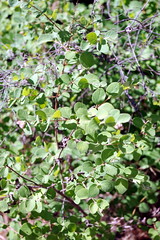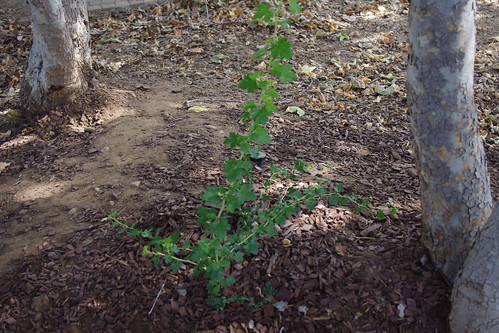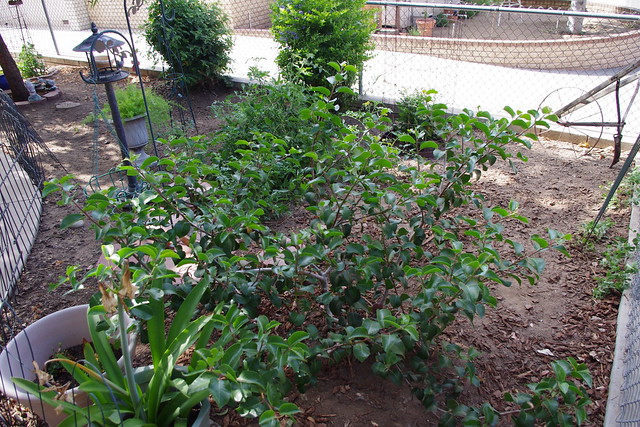 |
| Creeping Snowberry (Symphoricarpos mollis) |
 |
| Photo: Mine |
 |
| Photo: Mine |
Reservation along Hwy 76. numerous small creeping plants find a pleasant home in and among the Oak tree canopy and outer drip line of their crowns. This area is rich in Creeping Snowberry (Symphoricarpos mollis). They are perfect for planting under native California Oaks as those leaves are oval to rounded and easily fall through the small plants interior, where Sycamores with much larger leaves would be a major maintenance issue covering the plants. Besides, Oak Mulch makes a great compost and feed for the under story plants. Here is a much bigger link for which you may Zoom in. I found that other plants there do very well as companion plants. Native Currants, Ferns, even Coral Bells and Elderberry.
Magnified View of Symphoricarpos mollis
 |
| Photo: Kevin Franck (June 2013) |
This group of riparian trees above, Cottonwood, Willow and Mexican Elderberry are also associated with not only Snow Pea, but also Wild Rose. Do any of them look to be competing or chocking out their neighbours in some religious ritual known as "Survival of the Fittest" ??? Hardly. But blind faith in human construct dogmas are hard to weed out. And yes, many evolutionary concepts from an ignorant Victorian Era period have held on and ruined many an ecosystem ever since.
 |
| Photo: Kevin Franck (June 2013) |
This is an Oak Tree at the bottom of my brother's property in Ranchita California. This region in many ways is very much an interior high desert ecosystem. Very dry, cold/hot and windy at times from any direction. And yet, take a closer look underneath That Oak tree.
 |
| Photo: Mine |
On a much closer inspection, this is Chaparral Honeysuckle (Lonicera interupta) and may seem odd at first being way out on this dry flat, especially considering it is still recovering from the infamous Pines Fire of 2002. Yet, no doubt, some bird stopped at this weigh station rest area and took a literal dump for which it may have previously fed on Honeysuckle fruit. Or perhaps a Coyote or some other animal. They are not opposed to eating fruits, berries or seeds to supplement their diet of meat. In any event, there it is under an Oak tree. This plant however, is very tough and will fine out in the open, as another future post specifically on this particular plant will show. But it is a great plant to add under various trees among other natives out in your urban landscape back in the city.
 |
| Photo: Mine |
This plant here is abundant everywhere and photo is from Burnt Valley area of Anza California. It is Squaw Bush (Rhus trilobata). It can be confused by some for Poison Oak and if you are sensitive, it could cause some irritation. This is another beautiful plant, often overlooked, but has beautiful berries and deep Burgundy red Fall colouration. Goes well with similar plants under trees or Chaparral. All these plants will network well together above and below the ground, which ultimately should be your goal.
Next, these photos below are of my Mum's place and the plants I chose to fill in under the California Sycamore trees. These trees are deeply rooted and feeding from the aquifer below, but with good mycorrhizal networking and compatible companion plants with which the trees could interconnect with and mutualistically help each other survive. I know I keep drumming this Hydraulic Lift and Redistribution phenomena into the ground, but seriously, this should be basic elementary school stuff. But you simply don't hear these terms with reference to landscaping and gardening and yet everyone NEEDS TO! Anyway, below is what I chose and perhaps I should have done more of years before, but unfortunately left 7 years ago.
 |
| Photo: Mine |
 |
| Photo: Mine |
Both of these plants above are Chaparral Currant (Ribes malvaceum) These were purchased at Las Pilitas Native Plant Nursery at the Escondido store on old Hwy 395. These were planted my third week in El Cajon CA and inoculated with Mycorrhizal Fungal spores and beneficial bacteria from MycoApply. Again, I'd never plant any new plant without such applications. City-scapes are a mess and need reintroduction, despite what any naysayers will tell you. Do believe me ? Then proceed with the flawed conventional science-based recommended by commercial elements with a vested interest. These were extremely small when first planted. They are at time of photo six weeks old the day before I left there.
 |
| Photo: Mine Fuchsia Flowering Gooseberry(Ribes speciosum) |
I had one planted on the other side of these Sycamores, but under some Canary Island Pines and Tecate Cypress. I love this plant and put it there to not only fill in between three trees, but create a screen to keep my Mum's stupid Wiener Dog (Dachshund) out of there. Insane dog.
 |
| Photo: Mine |
 |
| Photo: Mine |
These next two are California Coffeeberry (Rhamnus californica) "San Bruno" dwarfed variety. I love these small Coffeeberries and they are placed towards the south end of the Sycamore drip-line. They should do excellent. The top photo has a plant that had lots of flowers, but no leaf buds. All energy was being put into flower production, but I'd rather have the leafs to begin with. The bottom one took off like a rocket with new growth, but something has been attacking it, and I'm assuming large Grasshopper as they were everywhere. In fact the Cat was capturing many. But it still looks to be doing very well.
 |
| Photo: Mine Western Redbud (Cercis occidentalis) |
There is another much larger plant to the right and above of this photo and it's 67 years old and doing wonderfully. Flowered for the first time this year. This plant was pathetic when I purchased it here, but with inoculation with Fungal spores and some watering, those pale (almost see through) leaves with red veins became large newer leaves with deep green. You can see one of the original tiny leafs at the bottom of this plant. It also coloured up nicely.
 |
| Photo: Mine |
| http://www.medford.watersmartgardening.com/eplant.php?plantnum=20596&return=l7_aR |
This plant, also purchased at Las Pilitas Native Plant Nursery is a Common Snowberry (Symphoricarpos albus laevigatus) or so I thought as it was labeled as such. The leaves appear different, so I'll have to wait for next visit. Still, it's a kool shady looking plant and was nothing before I planted it. It's grown wonderfully. The closest I could find as far as identification is from this link which labels is Smoothed Leaf Snowberry, but it's got the same identical scientific name. Here is a link to a northwestern gardening website in Medford Oregon. As you can see from a comparison of the photo above and the photo in the link below, there is clearly some distinct similarities with what is listed as (Symphoricarpos albus laevigatus)
 |
| Photo: Mine |
And finally, this is the same Sugarbush (Rhus ovata) I may have referenced at the start of my visit this year, but it's the final day there and I've since trimmed up the bottom and side branches to encourage more upwards growth with the multi-trunk. This is located on the south sun facing side of the California Sycamores. I'm hoping it will balloon up and out wider. Originally I wanted to create an example of a Chaparral Tunnel with that Laurel Sumac I had at the eastern end of the planter (still on the south facing side), but for which the neighbour freaked out and insisted it come out because it would destroy his block wall. It never would have, but oh well, to keep peace. You can see the trunk of the tree someone else put it. An African Sumac, not exactly my choice, but again, 'Oh Well'
~~~~~~~~~~~~~~~~~~~~~~~~~~~~~~~~
More reading:
http://www.laspilitas.com/nature-of-california/plants/symphoricarpos-mollis
http://www.laspilitas.com/nature-of-california/plants/lonicera-interrupta
http://www.laspilitas.com/nature-of-california/plants/ribes-malvaceum
http://www.laspilitas.com/nature-of-california/plants/rosa-californica
http://www.laspilitas.com/nature-of-california/plants/ribes-speciosum
http://www.laspilitas.com/nature-of-california/plants/rhamnus-californica-san-bruno
http://www.laspilitas.com/nature-of-california/plants/rhus-trilobata





